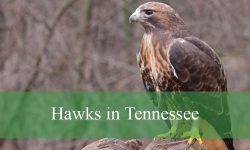A variety of woodpeckers can be found across Indiana, each with distinctive colors, calls, and habits. From the tiny and agile Downy Woodpecker to the impressive, towering Pileated, these birds add both color and sound to forests, parks, and even suburban backyards. Observing them in their natural habitats offers a unique glimpse into the state’s rich wildlife.
Woodpeckers are not just visually striking—they play a vital role in maintaining healthy forests by controlling insect populations and creating nesting cavities that other species can use. This guide will introduce you to all nine woodpecker species found in Indiana, providing detailed descriptions, identification tips, and pictures to help you recognize and appreciate these remarkable birds in the wild.
Types of Woodpeckers Found in Indiana
Red-headed Woodpecker (Melanerpes erythrocephalus)
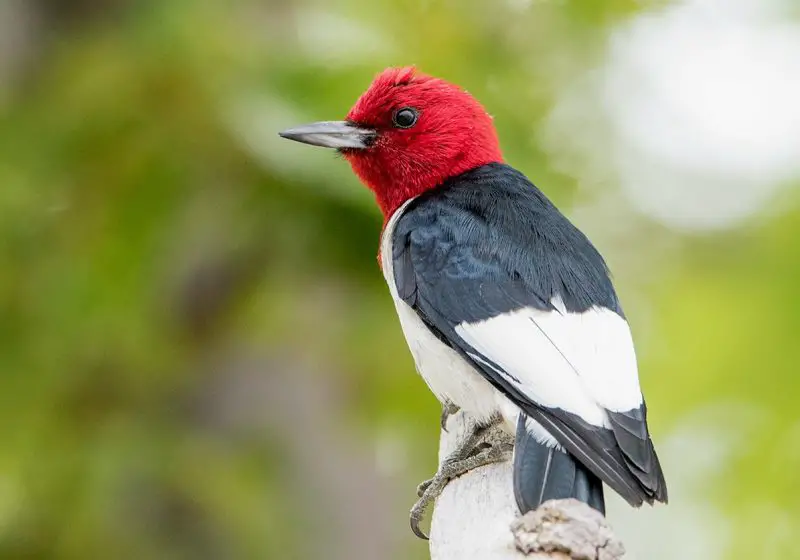
The Red-headed Woodpecker is one of Indiana’s most striking birds, easily identified by its entirely red head, neck, and throat, contrasted sharply with a white underbody and black-and-white wings. Its vibrant plumage makes it unmistakable even from a distance, and it measures around 7.5 to 9 inches in length with a wingspan of approximately 16 to 19 inches. Males and females appear similar, making gender identification challenging without observing behavior.
These birds are known for their acrobatic foraging habits, often catching insects mid-flight or prying insects from tree bark. They feed on a mixed diet of insects, nuts, fruits, and occasionally small birds’ eggs. Red-headed Woodpeckers are highly territorial, and they will aggressively defend both feeding grounds and nesting sites during the breeding season.
Nesting usually occurs in dead trees or large branches where they excavate cavities. The nest cavity is often reused in subsequent years. Both parents share incubation duties for about 12 days, and fledglings leave the nest roughly four weeks after hatching. These woodpeckers are cavity nesters but will also utilize old woodpecker holes created by other species.
In Indiana, the Red-headed Woodpecker is primarily found in open woodlands, forest edges, and near farmland. Populations have declined in some areas due to habitat loss, but they are still moderately common during the breeding season. They are migratory in the northern parts of their range but may stay year-round in southern Indiana.
Red-bellied Woodpecker (Melanerpes carolinus)
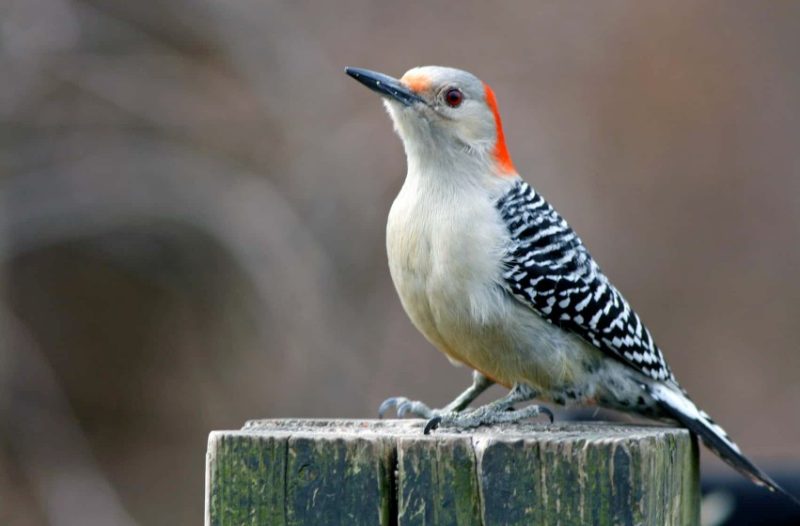
The Red-bellied Woodpecker is a medium-sized woodpecker commonly seen throughout Indiana. Despite its name, the red on its belly is subtle, while its head has a striking red crown extending from the bill to the nape in males, and partially in females. Its black-and-white barred back and pale underparts help in quick field identification. Adults typically measure 9 to 10 inches in length with a wingspan of 13 to 17 inches.
These woodpeckers are highly adaptable and frequently forage along tree trunks, branches, and even backyard feeders. Their diet consists of insects, acorns, seeds, and fruit. They are known for their persistent drumming, which serves both territorial and mating purposes. They are often active during the day, especially in the early morning and late afternoon.
Red-bellied Woodpeckers nest in tree cavities that they excavate themselves, usually in dead or decaying trees. Both males and females contribute to nest excavation and feeding of the young. The clutch size is typically three to six eggs, with incubation lasting about 12 days. Young fledge roughly a month after hatching.
In Indiana, these woodpeckers inhabit deciduous forests, suburban areas with large trees, and parks. They are year-round residents throughout the state and are frequently attracted to backyard feeders offering suet or peanuts. Their adaptability has allowed them to thrive even in urbanized landscapes.
Downy Woodpecker (Picoides pubescens)
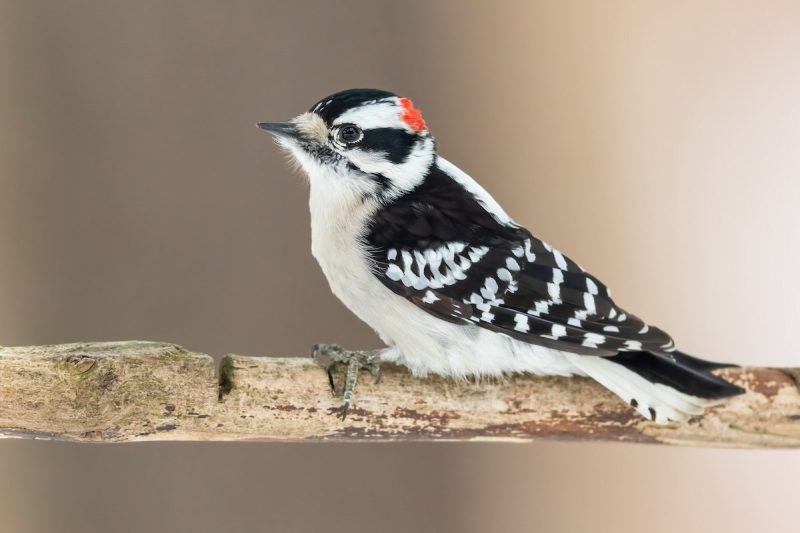
The Downy Woodpecker is the smallest woodpecker in Indiana, measuring 5.5 to 6.5 inches in length with a wingspan of 9.8 to 10.6 inches. It is easily recognized by its small size, white underside, black wings with white spots, and black-and-white striped head. Males have a small red patch on the back of the head, which females lack. Its short, stubby bill differentiates it from the similar Hairy Woodpecker.
Downy Woodpeckers primarily feed on insects, including beetle larvae, caterpillars, and aphids, but will also consume seeds and berries in winter. They often forage on smaller branches, twigs, and vines, displaying impressive agility as they cling to bark. Their drumming is soft but rapid, serving as a communication tool and territorial signal.
These woodpeckers nest in small cavities they excavate in dead branches or trees. Both sexes participate in digging the nest hole, incubating the eggs, and feeding the young. The typical clutch contains 3 to 8 eggs, with fledging occurring around three weeks after hatching. They often reuse or expand old cavities each season.
In Indiana, Downy Woodpeckers are widespread in forests, orchards, parks, and backyard habitats. They are year-round residents, frequently spotted at suet feeders and birdhouses. Their small size and active behavior make them one of the most common and recognizable woodpecker species in the state.
Hairy Woodpecker (Picoides villosus)
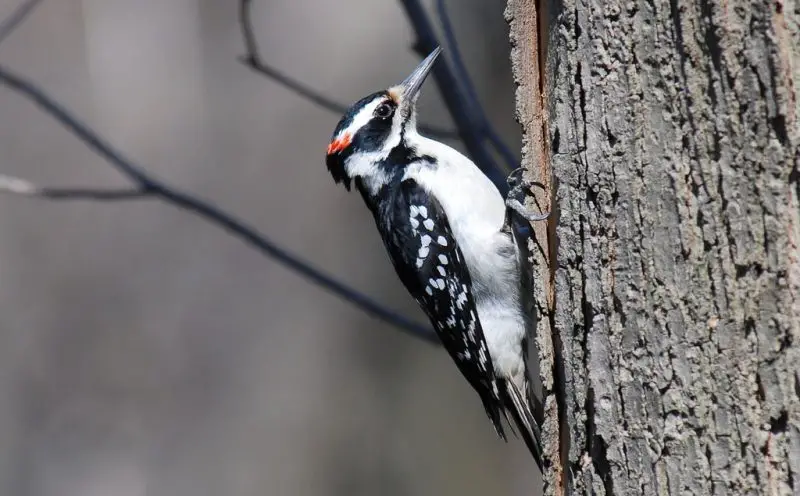
The Hairy Woodpecker is slightly larger than the Downy, measuring 9 to 10 inches long with a wingspan of 15 to 18 inches. Its plumage is similar, featuring black-and-white stripes on the head and back and a white underside, but it has a longer, stronger bill than the Downy. Males display a red patch on the back of the head, while females do not. Its size and straight, chisel-like bill are key identifiers.
Hairy Woodpeckers feed mainly on insects, especially wood-boring beetles and larvae, but they will also eat seeds, nuts, and occasionally fruit. They forage along trunks and large branches, often tapping and pecking deeply into bark to access insects. Their drumming is loud and deliberate, helping maintain territory and attract mates.
Hairy Woodpeckers nest in tree cavities that they excavate, usually in dead or decaying trees. Both male and female share duties of incubating 3 to 7 eggs and feeding the hatchlings. Fledging typically occurs four weeks after hatching. These woodpeckers sometimes reuse abandoned nests from previous years.
In Indiana, Hairy Woodpeckers inhabit mature forests, woodland edges, and occasionally large suburban trees. They are non-migratory and can be found year-round. Their preference for larger trees distinguishes their habitat choice from the smaller Downy Woodpecker, and they are commonly observed in both deciduous and mixed forests throughout the state.
Northern Flicker (Colaptes auratus)
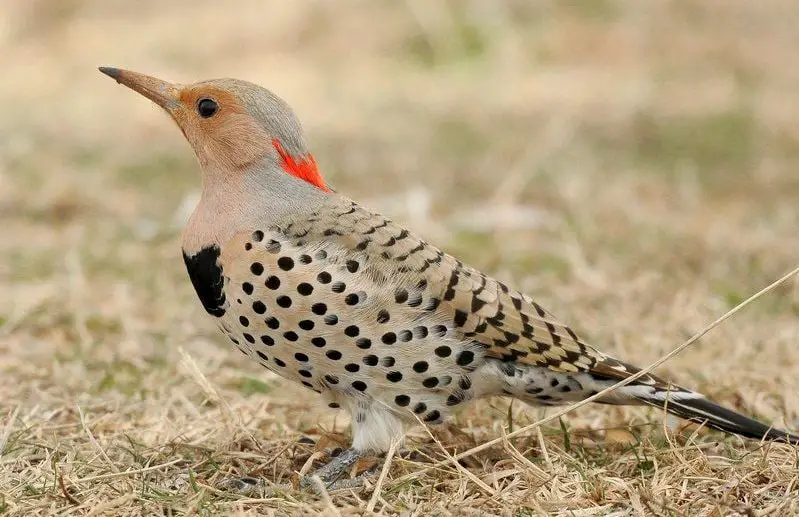
The Northern Flicker is a large, colorful woodpecker measuring 11 to 12 inches in length with a wingspan of 16 to 20 inches. It is easily recognized by its brown body with black spots, a white rump visible in flight, and a bright yellow or red shafted underwing depending on the region. Males display a black malar stripe on the face, which helps distinguish them from females. Its slightly curved bill and barred back make it distinct from other Indiana woodpeckers.
Northern Flickers are unique among woodpeckers because they spend a considerable amount of time foraging on the ground for ants and beetles. They also feed on fruits, seeds, and tree-dwelling insects. These birds are highly vocal, producing a loud, ringing “wick-a-wick” call, and their drumming is softer and less frequent than smaller woodpeckers.
They nest in cavities excavated in dead or decaying trees, often preferring taller trees for safety. Both parents share incubation duties for about 12 days, and fledging occurs approximately four weeks after hatching. Flickers may reuse old cavities, and sometimes multiple pairs may nest near each other in loose colonies.
In Indiana, Northern Flickers are common statewide, favoring open woodlands, forest edges, and suburban areas with scattered trees. They are migratory in northern areas but may remain year-round in southern parts of the state. Their ground-foraging behavior often makes them easier to spot than other woodpeckers.
Pileated Woodpecker (Dryocopus pileatus)
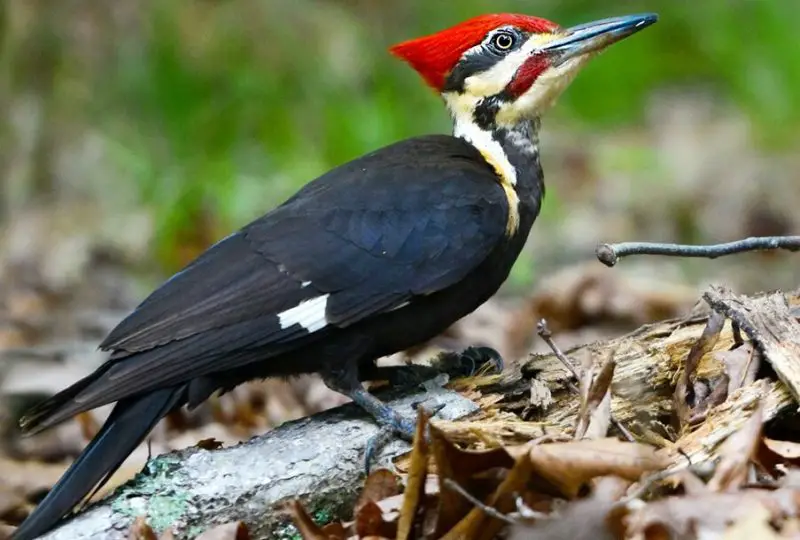
The Pileated Woodpecker is the largest woodpecker in Indiana, measuring 16 to 19 inches in length with a wingspan of 26 to 30 inches. It has striking black plumage with white stripes on the face and neck, and a vivid red crest on the head. Its large size, loud “wuk-wuk” calls, and prominent rectangular holes in trees make it unmistakable in the field.
These woodpeckers primarily feed on carpenter ants and other insects found under bark, but they also eat fruits and nuts. Their powerful bills allow them to excavate deep into wood, creating large rectangular feeding holes. Pileated Woodpeckers are territorial, often defending their feeding and nesting areas aggressively.
Nesting occurs in large tree cavities, usually in mature forests. Both parents help excavate the nest and feed the 3 to 5 chicks. Incubation lasts about two weeks, and fledglings leave the nest after approximately 4 to 5 weeks. Old nests are often reused or enlarged in following years.
In Indiana, Pileated Woodpeckers are widespread but prefer mature deciduous or mixed forests with abundant dead wood. They are non-migratory and can be observed year-round. Their distinctive drumming, vocalizations, and large feeding holes make them a favorite for birdwatchers.
Yellow-bellied Sapsucker (Sphyrapicus varius)
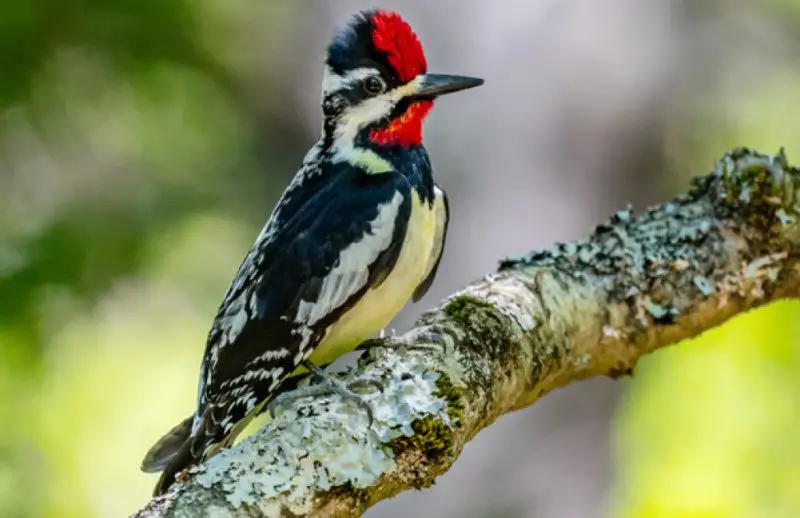
The Yellow-bellied Sapsucker is a medium-sized woodpecker, measuring 7.5 to 9 inches in length with a wingspan of 13 to 17 inches. It is recognized by its black-and-white striped face, red forehead, and yellowish belly. Males and females are similar, although males display a red throat patch. Its relatively small bill and neat plumage pattern help distinguish it from other Indiana woodpeckers.
These woodpeckers feed primarily on tree sap, drilling organized rows of holes in birch, maple, and other trees. They also eat insects attracted to the sap, as well as fruits and berries. Their feeding behavior often leaves characteristic “sap wells” that are easily identifiable in forests.
Yellow-bellied Sapsuckers nest in tree cavities, usually excavated in dead or decaying trees. Both sexes incubate the 4 to 7 eggs for about 12 days, and the young fledge roughly four weeks after hatching. They often return to the same trees each spring during migration.
In Indiana, Yellow-bellied Sapsuckers are migratory, passing through the state during spring and fall. They breed primarily in northern forests and are typically found in mixed woodlands, forest edges, and orchards during migration. Their presence is often signaled by their distinctive sap holes on trees.
Black-backed Woodpecker (Picoides arcticus)
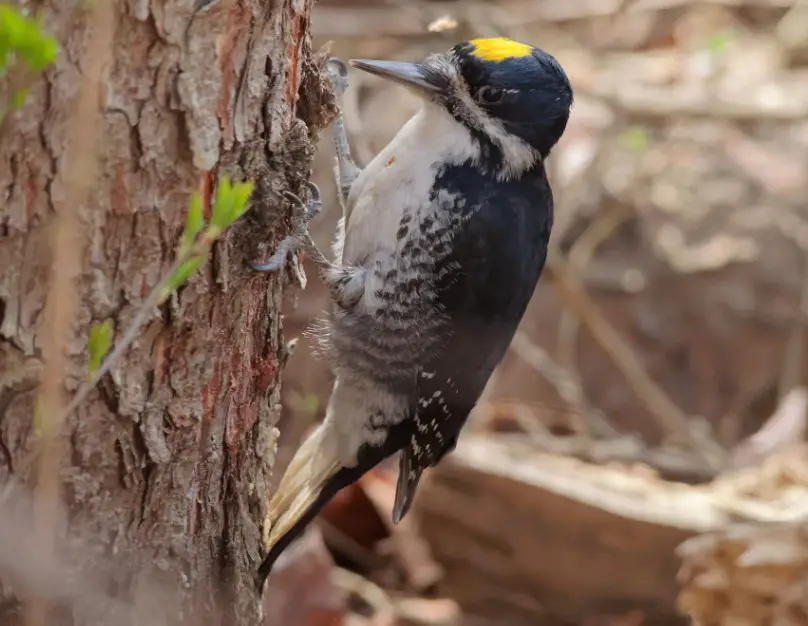
The Black-backed Woodpecker is a rare species in Indiana, mostly observed in northern forests during irruption years. It measures 9 to 10 inches long with a wingspan of 16 to 19 inches. Its jet-black back, white underparts, and yellow crown patch make it easy to distinguish from other woodpeckers. The slender bill and strong tail help it cling to burned or dead trees.
This species specializes in feeding on wood-boring beetle larvae, particularly in recently burned forests. They are highly adapted to post-fire habitats, excavating deeply into charred trees to extract insects. Their drumming is rapid and resonant, signaling territory or attracting mates.
Black-backed Woodpeckers nest in cavities they excavate in dead or burned trees. Both male and female share incubation of 3 to 5 eggs, which lasts about two weeks. Chicks fledge roughly four weeks after hatching. They are highly territorial, often defending burned patches aggressively against other woodpeckers.
In Indiana, they are extremely rare and largely restricted to the northernmost forested areas. Sightings are typically associated with years of high insect abundance or post-fire conditions. Birdwatchers must often explore remote forests during these irruption events to observe this elusive species.
American Three-toed Woodpecker (Picoides dorsalis)

The American Three-toed Woodpecker is an extremely rare woodpecker in Indiana, found mostly in northern forests. Measuring 8.5 to 10 inches long with a wingspan of 16 to 18 inches, it is distinguished by its black-and-white barred back, white underparts, and small size compared with the Hairy Woodpecker. Males display a yellow crown patch, while females do not. Its three-toed foot and strong bill are unique identifiers.
These woodpeckers feed primarily on wood-boring beetle larvae, often in recently burned or dead coniferous forests. They are specialized for foraging on trunks and large branches, using their stiff tail feathers for support. They also consume seeds and occasionally sap.
Nesting occurs in cavities excavated in dead or dying conifers. Both sexes incubate 3 to 7 eggs and feed the young, which fledge after approximately four weeks. They often reuse old cavities or nest in areas where previous years’ beetle outbreaks occurred.
In Indiana, American Three-toed Woodpeckers are extremely rare, mostly reported in northern forests during occasional irruption years. Their presence is unpredictable, and sightings are highly valued by birdwatchers. They prefer mature or burned coniferous forests, making them one of the most specialized and elusive woodpeckers in the state.
FAQs About Woodpeckers in Indiana
What species of woodpeckers can be found in Indiana?
Indiana is home to several woodpecker species, including the Red-headed Woodpecker, Red-bellied Woodpecker, Downy Woodpecker, Hairy Woodpecker, Northern Flicker, Pileated Woodpecker, Yellow-bellied Sapsucker, Black-backed Woodpecker (very rare), and American Three-toed Woodpecker (extremely rare).
How can I identify a Red-headed Woodpecker?
The Red-headed Woodpecker is easily recognized by its entirely red head, white underparts, and black-and-white wings. It measures 7.5 to 9 inches in length and is often found in open woodlands, forest edges, and near farmland.
What is the difference between Downy and Hairy Woodpeckers?
Downy Woodpeckers are smaller (5.5–6.5 inches) with a short bill, while Hairy Woodpeckers are larger (9–10 inches) with a longer, stronger bill. Both have black-and-white plumage, but size and bill length are key identifiers.
Where do Northern Flickers usually forage?
Northern Flickers often forage on the ground for ants and beetles, unlike most woodpeckers. They also feed on tree-dwelling insects and fruits. Their distinctive “wick-a-wick” calls can help locate them in Indiana forests and open woodlands.
Are Pileated Woodpeckers common in Indiana?
Pileated Woodpeckers are widespread in mature deciduous and mixed forests. They are the largest Indiana woodpecker and are easily spotted due to their size, loud calls, and large rectangular feeding holes.
What do Yellow-bellied Sapsuckers eat?
Yellow-bellied Sapsuckers feed mainly on tree sap, drilling organized rows of holes in birch, maple, and other trees. They also consume insects attracted to the sap, as well as fruits and berries.
How rare are Black-backed and American Three-toed Woodpeckers in Indiana?
Black-backed Woodpeckers are very rare and usually appear in northern forests during irruption years. American Three-toed Woodpeckers are extremely rare, mostly in northern Indiana coniferous forests during occasional irruptions.
Where do woodpeckers typically nest in Indiana?
Most woodpeckers nest in tree cavities they excavate themselves, often in dead or decaying trees. Both parents usually share incubation and feeding duties, with fledging times ranging from three to five weeks depending on the species.
Can I attract woodpeckers to my backyard?
Yes, species like Red-bellied, Downy, and Hairy Woodpeckers can be attracted using suet, peanuts, or sunflower seeds. Providing dead trees or large branches for foraging can also increase sightings.
When is the best time to observe woodpeckers in Indiana?
Many woodpeckers are year-round residents, such as Red-bellied and Downy Woodpeckers. Migratory species like Yellow-bellied Sapsuckers pass through during spring and fall, while rare species like Black-backed and American Three-toed Woodpeckers appear only in specific irruption years.



